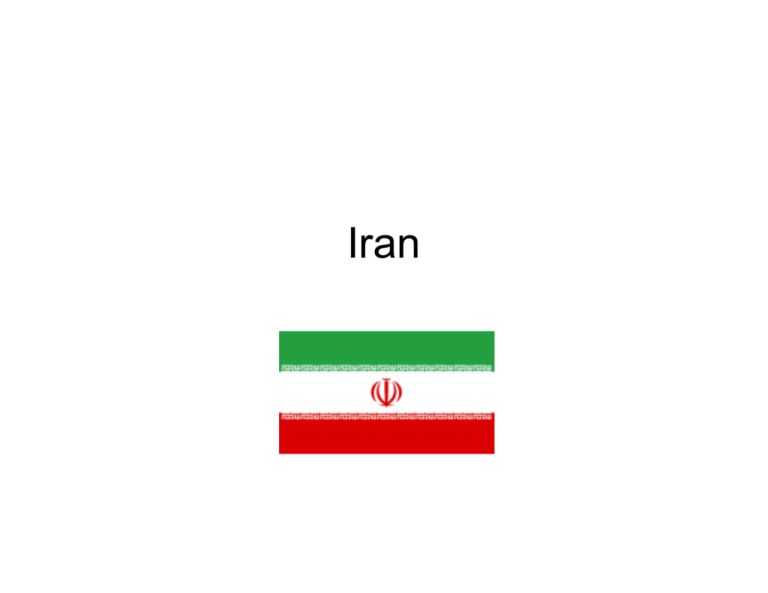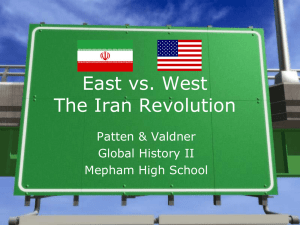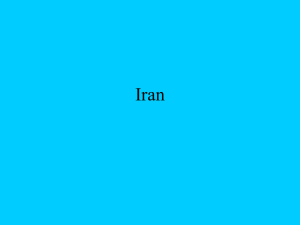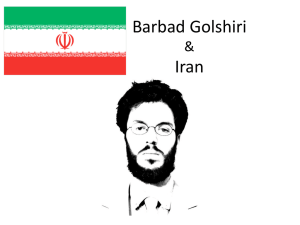Lecture Note
advertisement

Iran Reading • Wikipedia articles • CIA World Factbook Middle East Topography of Iran Basics • • • • Officially, the Islamic Republic of Iran Also known as Persia 2nd largest in ME with 78.4m population Home of one of the world’s oldest civilization History • The Achaemenid empire (550 BCE-) – Reached the pinnacle of power – Founded Cyrus the Great – The empire had a centralized, bureaucratic administration under the Emperor and a large professional army and civil services, inspiring similar developments in later empires. • Invasion of Alexander the Great (334 BC) • The Seleucid Empire • The Sassanid Empire (224 AD) – Byzantine-Persian Wars – Both defeated by invading Muslim Arabs Achaemenid Empire History • Arab invasion (7th century) – Rashidun Caliphate – Conversion to Islam – Arabization was never successful • The Khwarezmian Empire – Turkic mamluk origin • Mongol invasion (1219-21)* – Killed up to ¾ of the population (possibly 10 to 15 million people) History • The Safavid Dynasty (1501) – Established by Shah Ismail I – Instigated a forced conversion from Sunni to Shi'a Islam – Rivalry between with the Ottoman Empire – During Nader Shah's reign (1729 - ), Iran reached its greatest extent since the Sassanian Empire – Lost lands in the wars with Russia and British empires History : The Pahlavi Dynasty • Reza Khan overthrew the Qajar Dynasty, became Shah in 1921. He was forced (by the occupying Anglo-Russian forces) to abdicate in favor of his son, Mohammad Reza Pahlavi in 1941 – Mohammad Mosaddegh, elected PM and popular after nationalization of the Iran’s oil industry, was deposed in the 1953 coup.* • After the coup, the Shah became increasingly autocratic and sultanistic. (White revolution with the notorious secret police, SAVAK) • The Shah sent Khomeini into exile in 1964 • Oil price hikes and inflationary booms in 1974 • Economic recession in 1975-6, unemployment, organized protests again the Shah (The Islamic Revolution, 1979-) The Islamic Republic (1979 - ) • The Iranian Revolution came to be known as the Islamic Revolution. • A year of strikes and demonstrations paralyzed the country and its economy • The Shah fled the country and Ayatollah Ruhollah Khomeini returned from exile to Tehran in February 1979 • A new government was formed and in April 1979 Iran officially became an Islamic Republic, supported in a referendum with Ruhollah Khomeini as Supreme Leader (1979-89) The Shah and Ayatollah Khomeini The Islamic Republic (1979 - ) • Seizure of the US embassy and 52 hostages (Nov 1979) • Iraq under Sadam Hussein invaded Iran (Sept 1980), precipitating the Iran-Iraq War (Aug 1988) Iran under sanctions • Numerous governments and multinational entities impose sanctions against Iran. – Following the Iranian Revolution and the seizure of the US Embassy – In response to Iran’s continued illicit nuclear activities • Effects – http://en.wikipedia.org/wiki/Economic_sanctions – http://en.wikipedia.org/wiki/Sanctions_against_Iran Government and Politics • The Leader of the Revolution ("Supreme Leader") – Is responsible for delineation and supervision of the general policies of the Islamic Republic of Iran. – Is Commander-in-Chief of the armed forces, controls the military intelligence and security operations; and has sole power to declare war or peace. – Appoints the heads of the judiciary, the commanders of the police and military forces and six of the twelve members of the Guardian Council. – The Assembly of Experts elects and dismisses the Supreme Leader on the basis of qualifications and popular esteem.* • President of Iran as the highest state authority. – Elected by universal suffrage for a term of four years and can only be re-elected for one term. – Presidential candidates must be approved by the Guardian Council prior to running in order to ensure their allegiance to the ideals of the Islamic revolution. Iran’s political system Iran’s Oil Iran holds 10% of the world's proven oil reserves and 15% of its gas. It is OPEC's second largest exporter and the world's fourth oil producer. Tehran & Isfahan Economy • Iran's economy is a mixture of central planning, state ownership of oil and other large enterprises, village agriculture, and small-scale private trading and service ventures • Per capita GDP (PPP): 13,200 • See the summary sheet • In 2006, about 45% of the government's budget came from oil and natural gas revenues, and 31% came from taxes and fees. • Iranian budget deficits have been a chronic problem, mostly due to large-scale state subsidies, that include foodstuffs and especially gasoline.* • In 2010, the economic reform plan cuts subsidies gradually and replaces them with targeted social assistance. ** Economy • Leading manufacturing industries in the fields of carmanufacture and transportation, construction materials, home appliances, food and agricultural goods, armaments, pharmaceuticals, information technology, power and petrochemicals in the Middle East. • Economic sanctions against Iran, such as the embargo against Iranian crude oil, have affected the economy. Inflation GDP per capita Literacy rate Education IRR (Iran Rial) / USD Persian Kings in the Bible • Cyrus (539-530 BC) was the founder of the Mede-Persian Empire. He conquered the Media, Lydia, and Babylonian Empires. • He was a gracious liberator, and permitted the conquered nations to worship their own gods. • He was benevolent toward various captive people who had suffered under the rule of Nebuchadnezzar and his successors. • The Jews were allowed to return to Jerusalem to rebuild their temple and Cyrus even gave financial help. Persian Kings in the Bible • Darius (521-486 BC) defeated 9 kings (local uprisings) in 19 battles in 2 years. – He began the great work of Persepolis located 30 miles north of Shiraz. The main hall has the inscription, "I am Darius, great king, king of kings, king of lands -- who constructed this palace." – Darius was a good organizer of his kingdom. He established an efficient postal service. • Xerxes (486-465 BC) was Darius's son. He continued the war against the Greeks and continued building at Persepolis. • Artaxerxes (464-423 BC) was the son of Xerxes who continued building at Persepolis.







